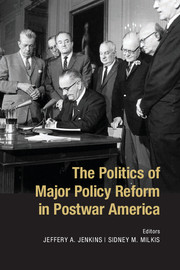Book contents
- Frontmatter
- Contents
- Contributors
- Acknowledgments
- 1 Introduction
- 2 The Long 1950s as a Policy Era
- 3 Regulation, Litigation, and Reform
- 4 Courts and Agencies in the American Civil Rights State
- 5 The Politics of Labor Policy Reform
- 6 Teachers Unions and American Education Reform
- 7 Progressive Federalism and the Contested Implementation of Obama’s Health Reform
- 8 Federalism and the Politics of Immigration Reform
- 9 Trade Politics and Reform
- 10 The Politics of Intelligence Reform
- 11 Follow the Leader
- 12 Conclusion: Madison Upside Down
- Index
- References
6 - Teachers Unions and American Education Reform
The Power of Vested Interests
Published online by Cambridge University Press: 05 November 2014
- Frontmatter
- Contents
- Contributors
- Acknowledgments
- 1 Introduction
- 2 The Long 1950s as a Policy Era
- 3 Regulation, Litigation, and Reform
- 4 Courts and Agencies in the American Civil Rights State
- 5 The Politics of Labor Policy Reform
- 6 Teachers Unions and American Education Reform
- 7 Progressive Federalism and the Contested Implementation of Obama’s Health Reform
- 8 Federalism and the Politics of Immigration Reform
- 9 Trade Politics and Reform
- 10 The Politics of Intelligence Reform
- 11 Follow the Leader
- 12 Conclusion: Madison Upside Down
- Index
- References
Summary
Shortly after taking office as President Barack Obama’s secretary of education, Arne Duncan was blunt in assessing the nation’s public schools. “It’s obvious the system’s broken,” he said. “Let’s admit it’s broken, let’s admit it’s dysfunctional, and let’s do something dramatically different, and let’s do it now. But don’t just tinker about the edges. Don’t just play with it. Let’s fix the thing”.
Such calls for major change in American education are hardly unusual. The consensus among policymakers – Democrat and Republican, liberal and conservative – is that the public schools are not providing the nation’s children with the quality education so necessary for a modern, competitive world.
This consensus has been the norm, however, for over a quarter century. A Nation at Risk warned in 1983 of a “rising tide of mediocrity” in America’s schools, convincing policymakers of the imperative for action – and the result, in the decades since, has been a whirlwind of reform bringing change upon change to the laws, programs, structures, and curricula of public education, as well as countless billions of extra dollars.
- Type
- Chapter
- Information
- The Politics of Major Policy Reform in Postwar America , pp. 129 - 156Publisher: Cambridge University PressPrint publication year: 2014



